Fuel Cell Industry Research: Hydrogen energy has been put on the national agenda with scenario application being rolled out.
The hydrogen energy industry has been included into the national energy strategy.
Since the 14th Five-Year Plan, ministries and commissions have intensively issued favorable policies for hydrogen energy, covering research on key technologies in hydrogen energy production, storage, transportation and use, demonstration application of hydrogen energy, infrastructure construction, etc.
In March 2022, the National Development and Reform Commission and the National Energy Administration jointly issued the Medium-and Long-Term Plan for the Development of Hydrogen Energy Industry (2021-2035), clarifying that hydrogen energy plays an important part in the national energy system in the future and is a key emerging industry of strategic importance, and proposing three five-year development goals for the hydrogen energy industry so as to meet the goal of emission peak and carbon neutrality.
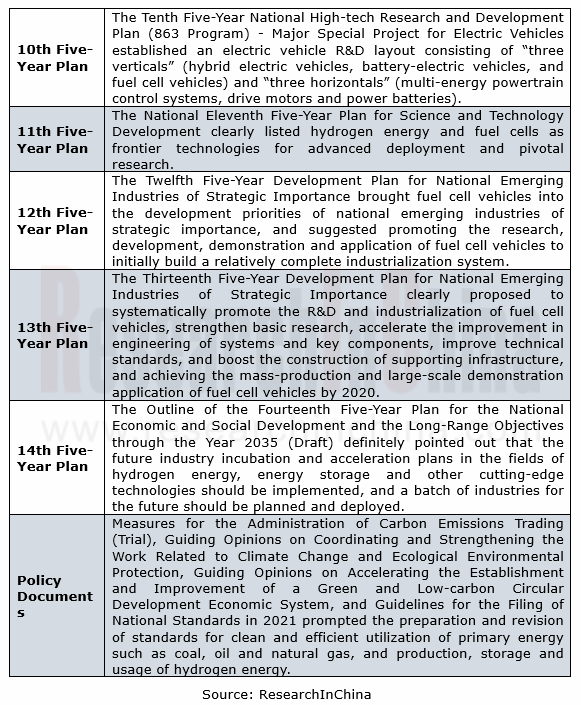
(1) Green hydrogen will be an investment hotspot in the future
China, the largest hydrogen producer in the world, boasts hydrogen capacity of about 40 million tons/a and output of about 33 million tons/a. In 2021, China produced about 33 million tons of hydrogen, up 32% year on year. In 2022, the output will jump by 15% on the previous year to 38 million tons.
In the short and medium term, China’s hydrogen is mainly made from fossil, partially from industrial by-products, but the proportion of hydrogen produced by renewable energy will ramp up year by year. By 2050, about 70% of hydrogen will be made from renewable energy, 20% from fossil and 10% from other technologies such as biotech.
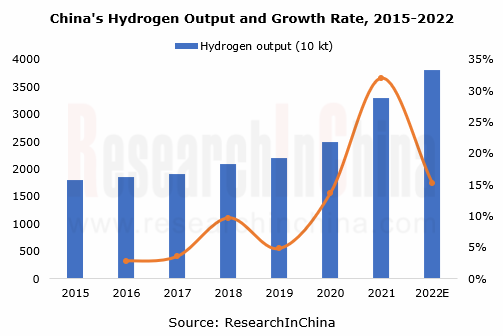
By region, China's hydrogen production is concentrated in Northwest and North China where fossils are abundant. China’s hydrogen market features a scattered competitive landscape: China Energy Investment Corporation and Sinopec are the largest hydrogen producers in China, accounting for about 30%; others are mostly small and medium-sized enterprises with a small hydrogen production scale. As other large enterprises dabble in the field of hydrogen energy, the hydrogen energy industry is expected to be more concentrated.
Green hydrogen is the key to the energy strategy and represents the development direction of the future hydrogen production. The huge market potential has attracted large energy enterprises, wind power and photovoltaic giants. From 2020 to 2022, China propelled the construction of several green hydrogen projects, such as hydrogen production from hydropower in Sichuan, photovoltaic hydrogen production in Xinjiang, and hydrogen production from wind power in Inner Mongolia, laying a good industrial foundation for large-scale production of green hydrogen.
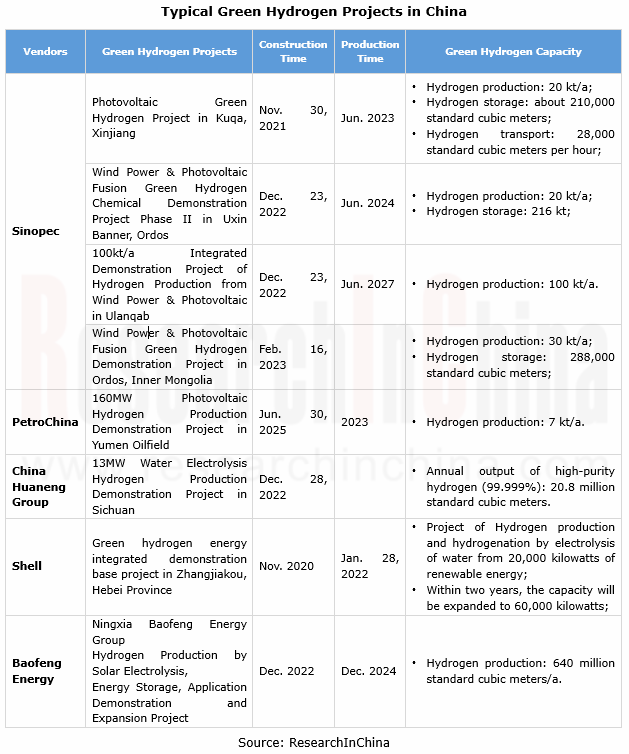
(2) Hydrogen storage and transportation will become the pipeline of the hydrogen energy strategy.
Commercial hydrogen is mainly transported in three forms: high-pressure gas hydrogen, low-temperature liquid hydrogen and hydrogen pipeline. At present, China mainly uses high-pressure gas hydrogen + 20Mpa long-tube trailers to transport hydrogen, which fails to meet the needs for large-scale use of hydrogen for the time being. In the future, as large-scale transportation of commercial hydrogen is in demand, China is bound to make progress in hydrogen storage materials.
For vehicle hydrogen storage in China, 35Mpa carbon-fiber-wound-type-III tanks are often seen, and 70MPa carbon-fiber-wound-type-III tanks have also been adopted in a small number of homemade vehicles. As concerns the future hydrogen storage and transportation technology, China will work on the standards and industrial application of 70MPa type-IV tanks, independent development of carbon fiber for gas tanks, and reduction of energy consumption and cost of hydrogen liquefaction, and make gradual breakthroughs in domestic civilian liquid hydrogen technology and equipment.
It is predicted that in 2025 70MPa type-IV tanks will be widely used, liquid hydrogen equipment will be initially self-developed, and a number of liquid hydrogen storage demonstration projects will be carried out.; by 2030, 98MPa type-IV cylinders will be produced on large scale at lower cost, and liquid hydrogen equipment will come into batch production at much lower cost and find broad application in mass storage and transportation at medium and long distances.
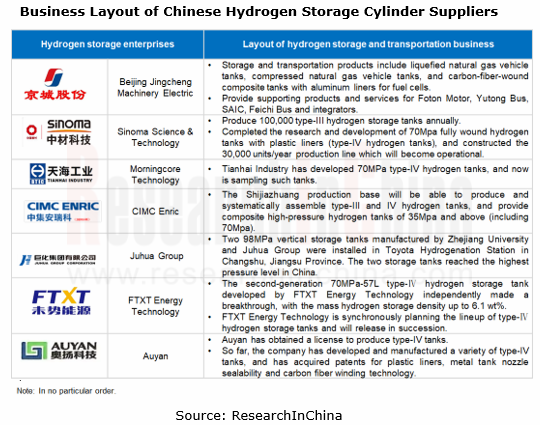
(3) Breakthroughs in localization of core fuel cell technology
The Guidance Catalog (First Batch) for the Application Demonstration of Key New Materials (2021) issued by the Ministry of Industry and Information Technology favors the breakthroughs in fuel cell technology, and the technological upgrade of hydrogen energy and fuel cell industries. The breakthroughs in manufacturing technology of core raw materials for fuel cells are the crux of cost reduction for China's fuel cell industry.
Accompanied by the construction of fuel cell model cities, the technological progress of China's core fuel cell material industry has obviously accelerated. Technological breakthroughs have been made in core materials in the hydrogen energy industry chain such as high-purity hydrogen, carbon fiber composites for hydrogen storage tanks, proton exchange membranes, catalysts, membrane electrodes, and gas diffusion layers, and production lines with considerable capacity have been built to produce some of them, providing the basis for further localization.
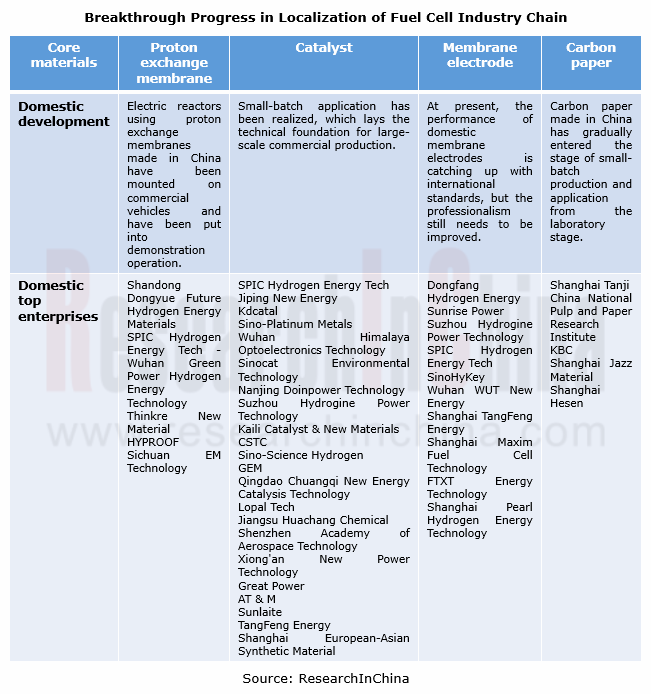
Under the joint influence of hydrogen energy policies and industrial chain cost reduction, China will build a complete hydrogen energy industrial system and diversified hydrogen energy application ecosystems covering transportation, energy storage, industry and other fields.
In the context of energy iteration, fuel cell vehicles have entered a new development cycle.
China's new energy vehicles have boomed, ranking first in the world for eight consecutive years. In 2022, the output and sales of new energy vehicles went up by 96.9% and 93.4% year on year to 7.058 million and 6.887 million units, respectively. Wherein, the output and sales of battery-electric vehicles jumped by 83.4% and 81.6% year on year to 5.467 million and 5.365 million units, respectively; the output and sales of fuel cell vehicles soared by 105.4% and 112.8% year on year to 4,000 and 3,000 units, respectively.
Hydrogen fuel cell vehicles and electric vehicles head in different directions. Hydrogen fuel cell vehicles will replace diesel engine vehicles in the future, while battery-electric vehicles will tend to substitute gasoline vehicles. Hydrogen fuel cell vehicles are positioned as a supplement to battery-electric vehicles. In many fields and scenarios where battery-electric vehicles are difficult to popularize, hydrogen fuel cell vehicles remain extremely superior.
Hydrogen fuel cell heavy trucks now have become a promising segment in development of fuel cell vehicles. Hydrogen heavy trucks/mine trucks can still run stably in low temperatures and harsh environments, covering the defects and shortcomings of battery-electric vehicles. In 2022, 4,782 hydrogen fuel cell commercial vehicles were actually sold, a year-on-year upsurge of 155.2%. Especially, hydrogen fuel cell heavy trucks were a strong performer, with the full-year sales of 2,465 units, rocketing by 216% on an annual basis, higher than the growth of 141% made by new energy heavy trucks, thus becoming the main force to drive the rapid growth of hydrogen fuel cell commercial vehicles.
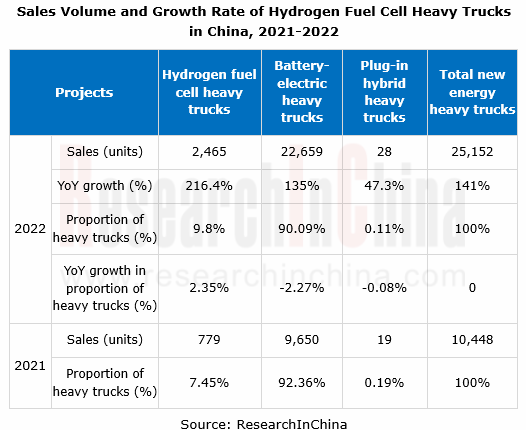
From the "49-ton fuel cell heavy truck project in Jiaxing Port Area", it can be seen that a batch of hydrogen energy equipment manufacturers have clustered and created a range of hydrogen energy application scenarios. Port logistics vehicles, forklifts and sea-river intermodal ships provide rich application scenarios for the hydrogen energy industry in Jiaxing Port Area. In May 2022, Zhejiang Feichi New Energy Vehicle Technology Co., Ltd. officially delivered 50 hydrogen heavy trucks to the national hydrogen fuel cell vehicle demonstration application program in Jiaxing.
In addition to hydrogen heavy trucks, hydrogen fuel cell special vehicles take a place in the demonstration area. Hydrogen fuel cell sweepers, hydrogen fuel cell refrigerated vehicles, hydrogen fuel cell logistics vehicles, and hydrogen fuel cell buses among others come into operation.
OEMs and Tier 1 Suppliers' Cost Reduction and Efficiency Enhancement Strategy Analysis Report, 2025
ResearchInChina released the "OEMs and Tier 1 Suppliers' Cost Reduction and Efficiency Enhancement Strategy Analysis Report, 2025", summarizing hundreds of cost reduction strategies to provide referen...
Automotive Fixed Panoramic Sunroof and Smart Roof Research Report, 2025
With the intelligent application of car roofs as the core, this report systematically sorts out a series of new products such as fixed panoramic sunroof/openable sunroof, ceiling screen, roof ambient ...
Automotive-Grade Power Semiconductor and Module (SiC, GaN) Industry Research Report, 2025
SiC/GaN Research: Sales volume of 800V+ architecture-based vehicles will increase more than 10 times, and hybrid carbon (SiC+IGBT) power modules are rapidly being deployed in vehicles.
Sales volume o...
Cockpit Agent Engineering Research Report, 2025
Cockpit Agent Engineering Research: Breakthrough from Digital AI to Physical AI
Cockpit Agent Engineering Research Report, 2025 starts with the status quo of cockpit agents, summarizes the technical ...
Prospective Study on L3 Intelligent Driving Technology of OEMs and Tier 1 Suppliers, 2025
L3 Research: The Window of Opportunity Has Arrived - Eight Trends in L3 Layout of OEMs and Tier 1 Suppliers
Through in-depth research on 15 OEMs (including 8 Chinese and 7 foreign OEMs) and 9 Tier 1 ...
China Commercial Vehicle IoV and Intelligent Cockpit Industry Research Report 2025
Commercial Vehicle IoV and Cockpit Research: The Third Wave of Passenger Car/Commercial Vehicle Technology Integration Arrives, and T-Box Integrates e-Call and 15.6-inch for Vehicles
I. The third wav...
Intelligent Vehicle Electronic and Electrical Architecture (EEA) and Technology Supply Chain Construction Strategy Research Report, 2025
E/E Architecture Research: 24 OEMs Deploy Innovative Products from Platform Architectures to Technical Selling Points
According to statistics from ResearchInChina, 802,000 passenger cars with domain...
Research Report on Intelligent Vehicle Cross-Domain Integration Strategies and Innovative Function Scenarios, 2025
Cross-Domain Integration Strategy Research: Automakers' Competition Extends to Cross-Domain Innovative Function Scenarios such as Cockpit-Driving, Powertrain, and Chassis
Cross-domain integration of ...
China Autonomous Driving Data Closed Loop Research Report, 2025
Data Closed-Loop Research: Synthetic Data Accounts for Over 50%, Full-process Automated Toolchain Gradually Implemented
Key Points:From 2023 to 2025, the proportion of synthetic data increased from 2...
Automotive Glass and Smart Glass Research Report, 2025
Automotive Glass Report: Dimmable Glass Offers Active Mode, Penetration Rate Expected to Reach 10% by 2030
ResearchInChina releases the Automotive Glass and Smart Glass Research Report, 2025. This r...
Passenger Car Brake-by-Wire (BBW) Research Report, 2025
Brake-by-Wire: EHB to Be Installed in 12 Million Vehicles in 2025
1. EHB Have Been Installed in over 10 Million Vehicles, A Figure to Hit 12 Million in 2025.
In 2024, the brake-by-wire, Electro-Hydr...
Autonomous Driving Domain Controller and Central Computing Unit (CCU) Industry Report, 2025
Research on Autonomous Driving Domain Controllers: Monthly Penetration Rate Exceeded 30% for the First Time, and 700T+ Ultrahigh-compute Domain Controller Products Are Rapidly Installed in Vehicles
L...
China Automotive Lighting and Ambient Lighting System Research Report, 2025
Automotive Lighting System Research: In 2025H1, Autonomous Driving System (ADS) Marker Lamps Saw an 11-Fold Year-on-Year Growth and the Installation Rate of Automotive LED Lighting Approached 90...
Ecological Domain and Automotive Hardware Expansion Research Report, 2025
ResearchInChina has released the Ecological Domain and Automotive Hardware Expansion Research Report, 2025, which delves into the application of various automotive extended hardware, supplier ecologic...
Automotive Seating Innovation Technology Trend Research Report, 2025
Automotive Seating Research: With Popularization of Comfort Functions, How to Properly "Stack Functions" for Seating?
This report studies the status quo of seating technologies and functions in aspe...
Research Report on Chinese Suppliers’ Overseas Layout of Intelligent Driving, 2025
Research on Overseas Layout of Intelligent Driving: There Are Multiple Challenges in Overseas Layout, and Light-Asset Cooperation with Foreign Suppliers Emerges as the Optimal Solution at Present
20...
High-Voltage Power Supply in New Energy Vehicle (BMS, BDU, Relay, Integrated Battery Box) Research Report, 2025
The high-voltage power supply system is a core component of new energy vehicles. The battery pack serves as the central energy source, with the capacity of power battery affecting the vehicle's range,...
Automotive Radio Frequency System-on-Chip (RF SoC) and Module Research Report, 2025
Automotive RF SoC Research: The Pace of Introducing "Nerve Endings" such as UWB, NTN Satellite Communication, NearLink, and WIFI into Intelligent Vehicles Quickens
RF SoC (Radio Frequency Syst...